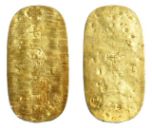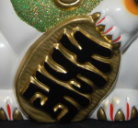Carrying some cash
The Lucky Cat is almost always depicted with a coin in its paws. The large, oval shaped coins are so-called Koban coins, which were used during the Edo period (1603-1868) in Japan. These coins were often used to trade with foreigners, who were fond of using gold as currency. The Japanese Yen is now the national currency of Japan, which was introduced in the Meiji period, but the Maneki Neko still holds true to history and nostalgia.
Japanese kanji can often be found written on the coins. The most common kanji is sen man ryo 千万両, which translates to 10,000,000 ryo, the currency used during the Edo period.[cf] - quite an amount! Chinese versions often have the word for ‘good luck’, fu 福, written on the coin. Others hold a full banner, with famous Chinese wishes of wealth increase, such as zhaocai jinbao 招财进宝, which translates to “let riches and treasures come in”.
The gold Koban coins on the cats relate back to folklore. These gold coins can be found hanging on the neck of the Lucky Cats, as well as in their paws, and they represent their generosity. They are said to be related to the good nature of cats, and the story behind the gold coins is described by Alan Pate. Unfortunately, it is a rather tragic one:
A fishmonger who did his rounds in Edo would make a daily stop at a money changer named Tokita Kisaburo to conduct business. He would always have a scrap or two of fish for the money changer's cat . This was the routine for some time. But the fishmonger fell ill and was unable to make his usual rounds. While ill he awoke one morning to find two gold coins by his futon. He was quite puzzled by this, wondering who had left him these coins, but they came in handy, helping him through this period when he could not work. After recovering he expected to find the cat at the money changer's as before. When the cat did not appear for his treat, the fishmonger asked about the cat. The money changer coldly responded that he had killed the cat: one morning he had noticed two gold coins missing and assumed they had been stolen. The next morning he had found his cat slinking away with another coin in its mouth which he immediately retrieved. The following morning he awoke to find the cat stealing yet another coin. So in anger he had killed the thieving cat. The fishmonger was filled with sadness and told the money changer his story of finding the two coins by his bedside during his illness, concluding that the cat had tried to repay the fishmonger for all his kindness. Grieving over his mistake the money changer gave the fishmonger the two gold coins the cat had intended for him. Later, a tombstone was erected commemorating the cat's generosity, saying: "A male animal which did virtuous and good acts."[cf]



